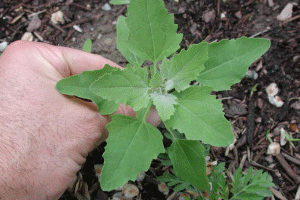Our vegetable gardens never seem to grow quite fast enough in the spring. Even for those of us who plant spinach and other vegetables early on, the wait from garden to table is too long. But we don’t always have to plant in order to harvest.
Some of the weeds we’re digging out of lawns and landscape beds can be harvested for eating. It’s hard to get fresher or more local than the walk from lawn to table. Though they can be harvested from other places as well, you will want to carefully identify them (botanical names are included below) and make sure they weren’t sprayed.
Below are some common weeds that can put fresh food on the table at the same time as you’re cleaning up your lawn.
Dandelion greens, Taraxacum officinale, can be used in salads, sautéed, or used for pesto, tea, quiche, pasta sauce or any other ways you would use greens.
Curly or sour dock, Rumex crispus, is difficult to eradicate so it’s a great one to “recycle.” Harvest only the tender, young leaves from the center of the rosette in early spring. Once cooked, the leaves will fade to a dull khaki color for wraps or roll-ups. Folklorist Roger Welsch, author of Weed ‘Em and Reap, recommends boiling or steaming the young leaves, adding fresh lemon juice, bacon grease or butter and salt for a “first rate, and very wholesome, vegetable green to go along with your T-bone steak.”
Common milkweed, Asclepias syriaca. To get rid of the toxic milky sap in young shoots and immature fruit pods, they need to be boiled and the water discarded. Their cooked flavor is similar to green beans. Later in summer their flower clusters can be dipped in fritter batter and dusted with powdered sugar; or immature green pods can be boiled for 10 minutes, drained and eaten plain or stuffed with meat, cheese or vegetable fillings.
Stinging nettle, Urtica dioica. Nettles have to be harvested early in spring and even then, they need to be gathered with gloves to avoid the sting. But once cooked the stinging hairs dissolve and are harmless. Nettles taste like collards, kale or spinach. You can also dry the leaves for nettle tea, a natural anti-inflammatory and pain reliever that has 17 essential vitamins and minerals, lycopene and several other beneficial phytochemicals.
Lamb’s Quarters, Chenopodium album. Very young leaves can be eaten raw; older leaves can be cooked and used like spinach. Kay Young’s Wild Seasons has a recipe for creamed lamb’s quarters with mushrooms. Like its cousin quinoa, it’s a super-food—high in Vitamins A and C, riboflavin, niacin, calcium, manganese, potassium and iron.
Purslane, Portulaca sativa, can be used much like spinach. It has a slightly sour taste but the stems, leaves and flower buds can be eaten raw in salads. Like okra, it has a mucilaginous quality when added to soups, stews or casseroles. Purslane contains more omega 3 fatty acids than any other plant source, as well as vitamin A, B, C and E (six times more vitamin E than spinach), seven times more beta carotene than carrots, as well as magnesium, calcium, potassium, folate, lithium, iron and protein.
Nebraska Statewide Arboretum is a nonprofit that works toward sustainable home and community landscapes through initiatives in education, public gardens and the environment. Plant and landscape resources at http://arboretum.unl.edu.

